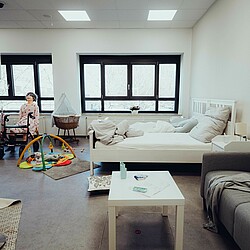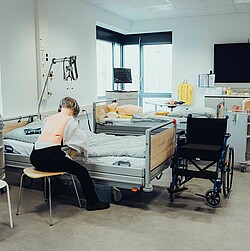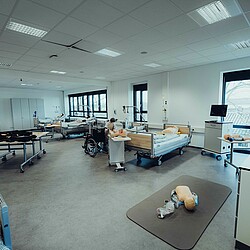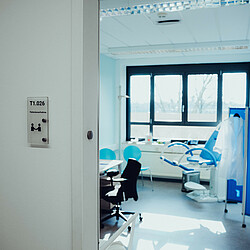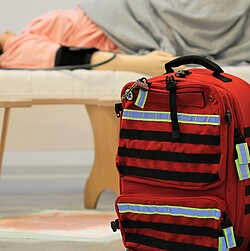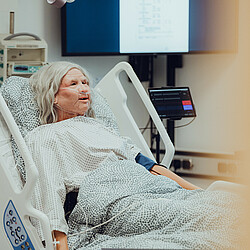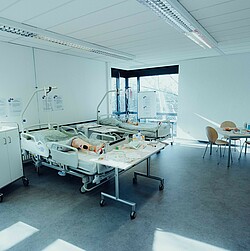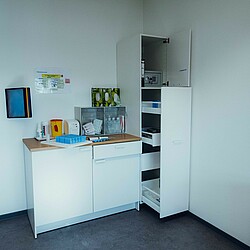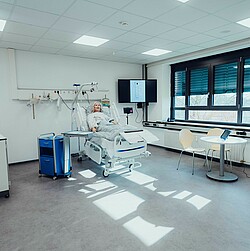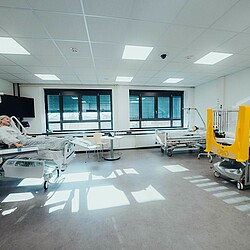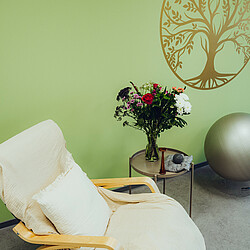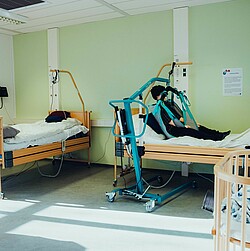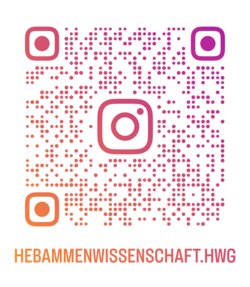Skills and simulation center for midwives and nurses
Midwives and nurses need comprehensive knowledge for their responsible work, but also routine in the actions they have to carry out on a daily basis or only in an emergency.
Confidence is gained through regular practice. The confidence gained also leads to greater safety in patient care and protects them from incorrect treatment.
In our skills and simulation center, important skills and abilities for everyday professional situations are trained in realistically designed rooms.
In addition to the learning locations "theory" (university) and "practice" (clinical and outpatient settings), the third learning location "Skills and Simulation Center" enables practical skills to be trained before they are used in practice on real people.
Learning methods
After acquiring important theoretical knowledge in lectures and seminars, the associated skills and abilities are trained in the skills and simulation center. These are deepened and expanded in subsequent practical assignments. Experiences from the practical assignments are also reflected on in the skills and simulation training. This allows students to further develop their own skills and transfer them to different situations.
The Skills and Simulation Center uses skills training and simulation as learning methods, which are anchored in the didactic concepts of both degree programs and build on each other semester by semester.
It is important to us that students first master the skills before linking them to chains of action in case studies and simulations and applying them to specific situations. Knowledge and complexity increase as the course progresses and our methods adapt accordingly.
Skills training
Skills training refers to the learning and training of individual skills and abilities that are required to perform an action correctly. Using the cognitive apprenticeship method, individual actions are trained and reflected on in small groups with the help of action plans and checklists.
Simulation
During the simulation, complex situations are practiced and reflected upon. This enables learners to learn how to act in different situations and develop their skills. The situations are based on real-life professional situations. In addition to the skills of individual learners, teamwork can also be practiced, e.g. in emergency situations.
During the simulation, either fellow students, simulation persons or simulators & models (e.g. a full-body doll or body parts) can be used in the role of the patient.
The simulation follows a fixed structure. In the run-up to the actual simulation, all participants are trained about the situation to be simulated and their roles. This is followed by the actual simulation of the professional action situation (Gabler, 2019, cited in Schlegel et al. 2020). The simulation is then debriefed and the resulting insights are jointly developed and transferred to practical action (Schlegel et al., 2020).
As a rule, the simulation training takes place following or building on the skills training, so that the learners first practice core skills and then use these skills and existing knowledge to master complex and highly complex case situations.
The debriefing of the simulations always follows a predefined structure so that students and educators can focus on the content in order to gain the greatest possible benefit from the simulation.
Goals
The Simulation Network Education and Training in Nursing (SimNAT Nursing) specifies the following objectives for learning in skills and simulation training:
Enabling the acquisition of skills, abilities and knowledge in a risk-free and anxiety-free learning environment and gaining confidence in one's own actions
Improvement of professional competence
Promoting the safety of patients (Loewenhardt et al. 2014, 65 cited in Sander, 2017, p. 3)
Interprofessionalism
At the Ludwigshafen University of Business and Society (HWG), the training takes place in a skills and simulation center for the primary qualifying degree programs in midwifery and nursing. The joint use also opens up potential spaces for interdisciplinary training and thus promotes interprofessional exchange.
It is important to us that our education staff have the appropriate professional qualifications as midwives, in nursing or medicine and, in addition to professional experience, also have the appropriate pedagogical teaching qualifications and experience in this field.
We also regularly undergo further professional and pedagogical training - e.g. as part of the CRM simulation instructor training or on the use of other digital methods.
Technical equipment: Video debriefing system
Video debriefing system
In our modern skills and simulation center, we use a sophisticated audio-video debriefing system to make our simulation training even more effective. This innovative system enables detailed analysis and reflection of training scenarios and is a central component of our education and learning concept.
How does the audio-video debriefing system work?
Our system captures simulations in real time using multiple cameras and microphones strategically positioned in the training rooms. This technology provides:
Transmission of the simulation: the simulation can be observed by students and lecturers in dedicated rooms without disturbing the simulation participants too much.
Video recordings: High-resolution videos document the interactions of the participants in the simulation scenario.
Audio recordings: Clear audio recordings allow verbal communication and decision-making processes to be tracked.
Synchronization with medical technology: The recording of monitor displays (e.g. vital parameters, CTG) is directly linked to the videos in order to present the simulation in an overall context
Advantages for the participants
Targeted reflection: Participants can view their actions and decisions from an objective perspective afterwards.
Analyze team communication: The audio recordings make it possible to specifically evaluate the quality of teamwork and communication.
Recognize potential for improvement: Mistakes or suboptimal processes become visible and can be discussed and corrected in a safe environment.
Debriefing as a central component
The debriefing takes place in a specially equipped seminar room where the recorded scenarios are analyzed. We rely on:
Feedback culture: Our trained team supports the participants in dealing constructively with their performance.
Simulation as a protected learning space: it is not about evaluation, but about learning and further development.
Focus on core competencies: Communication, teamwork, professional competence and clinical decision-making are the focus.
Areas of application
The audio-video debriefing system is used in various training courses, including
Emergency management
Interprofessional team training
Specific skills, such as resuscitation training.
By integrating audio-video debriefing technology, we are helping to improve patient safety and the quality of nursing and obstetric care in the long term. At the same time, we are creating a learning environment that combines state-of-the-art technology with evidence-based teaching methods.
Rooms
Delivery rooms
The delivery rooms reflect the support of births in clinical and non-clinical settings. Technical equipment, monitor rings and the relaxed and homely atmosphere of a birth center can be experienced in the rooms and used for training and simulation.
Nursing room
In the clinical setting, a room is prepared for the care of patients requiring monitoring, which is also equipped for care in the pediatric area from infants to adolescents.
A large patient room with 5 beds is mainly used by both degree programs for training in the first semesters and can be flexibly designed with special equipment and furniture.
Apartment
Designed like a typical living environment to simulate scenarios from the field of outpatient care, but also for supporting mothers/families in the first period after the birth. The sleeping, living and kitchen areas as well as a barrier-free bathroom provide the perfect backdrop for experiencing the challenges of home care.
Patient room setting
The room with low-corridor beds, nursing chairs and an overall quiet atmosphere offers the opportunity to concentrate on the requirements of caring for chronically ill and elderly people.
By changing the equipment (changing unit, extra bed), the room can be used for clinical postnatal care.
Admission and ward room
We have both a patient admission area and a ward room that can be used as part of the simulations so that we can enter into scenarios in line with the situation or train admission situations, handovers or case discussions, for example.
Movement room and seminar rooms
We have several rooms equipped with the appropriate media technology for the implementation of course concepts, larger groups, practical theory seminars or for briefing and debriefing as part of simulations.
Skills and simulation center in action
Pictures from the skills and simulation center
Interprofessional cooperation is very important to us in the degree programs, which is why some training courses are designed to be interprofessional. For example, in the first and third semesters of nursing, the topic of breastfeeding is taught by an education specialist from the midwifery course during the training on nutrition management and pediatrics.
Resuscitation training for both degree programs is provided jointly by an education specialist from the nursing degree program.
To get more insights into our degree programs, you are welcome to follow us on Instagram (scan the QR code or click on the QR code).
Sources:
- Sander, S. (2017). Skills lab in nursing training. Opportunities and challenges.
- Schlegel, C., Schaer, U.-B. & Droz, M. (2020). High-fidelity simulations in nursing education.


